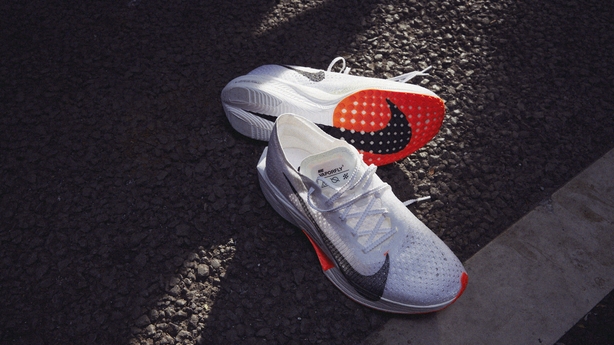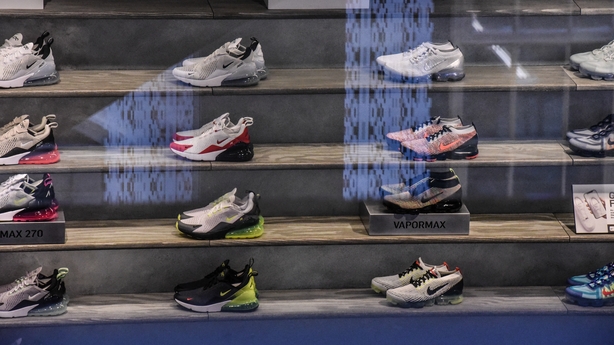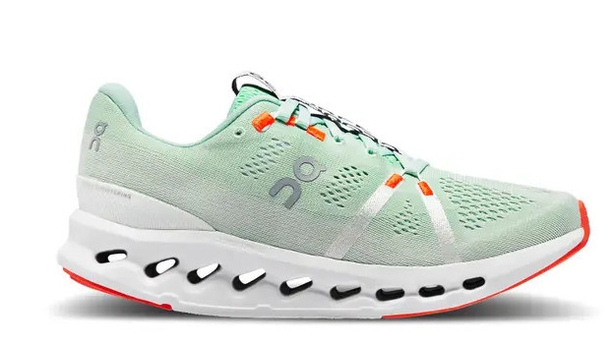Nike has long been the king of sportswear – but now its crown could be in trouble.
Founded in the 1960s – and originally called Blue Ribbon Sports – it has been a dominant force in the athletic and sports wear market since the 1980s. That was the decade when it started to move from focusing largely on footwear for runners to creating product lines for other sports.
It's also the decade when it signed up a young Michael Jordan, leading to the creation of Air Jordans, which were a pivotal product and bit of marketing for the company.
And since then, when you’re talking about sportswear, it’s been Nike followed by Adidas. And then there’s a big gap before you get to all of the other brands. Some smaller companies might have dominated in particular sports or particular countries – but broadly speaking Nike has been the market leader, and the rest have been playing catch up.
Until now.
So what’s gone wrong?
To answer that you need to go back to just over five years ago.
In January 2020, John Donahoe became the new CEO of Nike. He didn’t have a sports or fashion background – he had previously been CEO of consultancy firm Bain & Company and then moved into tech, taking senior roles in Ebay and ultimately cloud computing company ServiceNow.
Given that mix of consultancy and tech expertise - he was seen as the right man to help bring the company forward.
But of course he didn’t have his feet under the desk all that long when he had to deal with a major shock to the business – the Covid-19 pandemic. The first big impact that has on a brand like Nike is that retail around the world shut down.
At this point in time Nike was a retailer itself, but far more importantly were the relationships it had with other retailers – the likes of sports shops, department stores and so on. They are the places where the vast bulk of Nike products are bought and sold each year.
But when the pandemic hits, all of that closes.
We need your consent to load this rte-player contentWe use rte-player to manage extra content that can set cookies on your device and collect data about your activity. Please review their details and accept them to load the content.Manage Preferences
Coinciding with that, though, is a spike in demand for sporting goods – for runners, sports wear and fitness accessories – as all of the people locked down at home are looking for ways to keep themselves busy, to get fit or to stay fit. And because all of the shops were closed, they of course went online to find what they wanted – which lead to a spike in orders through Nike’s website. Of course it would have sold goods online before, but until then physical retail was where most of the sales were done.
But this dramatic shift, pretty much overnight, prompted Donohoe to push even harder on a strategy that was already underway at Nike – which was to move closer to the direct to consumer (DTC) model. This was a strategy that had already been started before he took up the CEO role, but the pandemic gave him the opportunity to accelerate it. The idea was that, rather than relying on middlemen to sell its goods, Nike would shift its focus towards selling more directly – through its website, but also through an expanded network of physical stores.
And that would allow it to have a direct relationship with the consumer – it also meant it wouldn’t have to fight for shelf space in stores and it would get to keep all of the money from the sale. There wouldn’t be any retailer in the middle that was looking to take its cut.
Which is all good news for the company’s bottom line…

Yep, and shareholders loved it – if you look at Nike’s share price in 2020, there’s a brief dip in early March, when lockdowns started coming into force and everyone briefly thought there was going to be a global recession.
But it quickly recovered from that and, a year on from that dip, its shares were up nearly 100%. By late 2021, they were more than 160% higher. Because here you had a major company that was enjoying a boom in demand, and was taking more money from each product sold. It was a dream come true.
At least until reality began to hit.
Because Nike’s DTC plan wasn’t just about selling online, it was also about setting up more physical shops around the world. That requires a lot of capital investment and planning. And as any retailer will tell you, it’s high risk – even if you have major name brand recognition like Nike, it’s not a guarantee that your shop will make a profit.
But being the retailer also creates other headaches – for example, if you have a line of products that don’t sell, that’s now 100% your problem. Compare that to a retail partnership, where the shop would have to take some or all of the hit in terms of selling them at a discount or writing them off.
That kind of stuff is probably managable for a big brand like Nike, though. It might take them time but they’d eventually work through the kinks. But in the end the sudden shift to the DTC model hurt them in a different way.
How is that?

Nike’s partnerships with retailers used to be central to their business – not just because it allowed them to outsource the actual selling of their products, but because it acted as a massive marketing machine for the brand.
Because the good relationships Nike would have had with sportswear chains and department stores meant they would have had plenty of prominent shelf space, so they could offer a wide range of goods. There would have been lots of promotional material in their shop windows – and maybe staff that were willing to recommend the brand to customers too.
And that matters because sportswear shops are in far more places than Nike will ever be – they’re relatively accessible to consumers, and they give people choice, or at least the illusion of choice.
So if someone is taking up a new sport and they need runners or shoes, the chances are they don’t know which ones they’re going to like. To figure that out they’ll probably will want to try a few pairs from a few different brands before they decide, and maybe get some advice from an 'expert’. To do that they’ll go to a shop that has a range of brands to see what they like, and what’s in their price range.
Now there’s every chance that they end up liking Nike’s offering – and decide to stick with that brand for future purchases. Maybe at that stage they’re happy to go straight to Nike’s shop or website to make their purchase – but they had to go via the sports shop first before they became a loyal Nike customer.
But by scaling back on its relationships with retailers, Nike was giving up that ground. In some cases it reduced the products it was offering to retailers, meaning there was less choice for customers – in other cases, like with Macys in the US, it completely ended its relationship – meaning there were no Nike products on offer in its stores for a time.
And that left retailers with a lot of empty shelves?

Well this is at the core of Nike’s mistake - it left a lot of gaps in stores that would traditionally have been taken up by their products. And retailers don’t like empty shelves, so they turned elsewhere to fill them.
And some of that space was taken up by old rivals like Adidas, Puma, Asics and so on – but it also opened the door for new brands like Hoka and On Running. Both of those were set up – separately – around 15 years ago, and were relatively niche products in the running community for much of that time, but a mixture of social media buzz, and retailers looking for brands to fill gaps, gave them the opportunity to explode in popularity.
Decker, which owns Hoka – as well as Ugg Boots, by the way – said it sold $571m worth of Hoka gear in the three months to the end of September 2024. That’s more than seven times the amount it made in the same quarter of 2020.
On Holdings has seen its revenues more then triple between 2021 and 2024 – and its profits have more then tripled in that time too.
And a large part of the reason for that is because Nike ceded the battlefield to these rivals.
Adidas has also seized on Nike’s weakness to try to push its brand globally. It now has the aim of being the biggest sports brand in every country (bar the US). However it is also being challenged by the growth of Hoka and On – and is still recovering from the implosion of its relationship with Kanye West. Just today it said its growth would be slower than predicted, and it’s announced 500 job cuts at its German headquarters in order to try to reduce costs.
Has Nike admitted its mistake?
To an extent, yes.
Back in April 2024, CEO John Donahoe said that they may have moved too quickly in shifting away from working with retailers and towards the DTC model. But he also doubled down on this being the right move to make – saying it was about giving customers what they wanted, when they wanted it.
In June the company announced a worse-than-expected fall in sales – which prompted shares to fall by 20% in one day. That wiped about $28 billionoff its value in one foul swoop.
The share price is now 55% lower than its 2021 peak – and, having spiked on the back of the Covid bounce, it is now pretty much back to where it was at the start of the pandemic.
Shortly after that June announcement, Nike’s co-founder Phil Knight said the company was standing by Donahoe and he had their "unwavering confidence and full support". For anyone who watches politics, that was sure to sound alarm bells.
And sure enough, Donahoe was ousted in September of last year, and replaced by Elliot Hill. He’s a 32 year veteran of Nike, starting out an intern and working his way up to senior management before retiring in 2020. He was brought out of retirement to turn the ship around.
And that’s not just about repairing relationships with retailers – because there’s also a feeling that the brand isn’t innovating the way it used to, it’s missing out on trends that its smaller and more nimble rivals are capitalising on. People even feel that Nike was late to react to the resurgence in the popularity of running which happened in the wake of the pandemic, which is somewhat ironic given the fact that running is where Nike started out.
It's also not had the same cultural relevance as it used to – like that game-changing deal it did with Michael Jordan, or the ‘Just Do It’ campaigns over the years.
And is that were Kim Kardashian comes into play?

That’s definitely part of it – this is a partnership between Nike and Kardashina’s ‘Skims’ brand – which is a shapewear company.
This is going to be a new sub-brand – NikeSkims - and it’s not yet clear what exactly the products will be. Part of Nike’s attempted turnaround has been a promise to return to focusing on sports, so the expectation is that it will be some kind of shapewear/athletic or performance-wear hybrid.
But of course, a big part of the attraction for Nike is to have the juggernault of a brand that is Kim Kardashian on-side to promote the whole thing. Some would argue that she is past the peak of her promotional powers. But at the same time Nike – and others - are struggling to find the kind of mega-star brand ambassador that they might have in the past.
If you think back to that Michael Jordan deal – he was a huge star, and that deal was brand-defining. The same goes with its long-running deal with Tiger Woods. More recently Nike has spent a lot of money to keep Christiano Ronaldo as one of its stars - but he’s an old man by sporting standards. And while Nike has plenty of other sponsorship deals with soccer players, athletes, baseball players and so on – there aren’t really any that have the kind of global, break-through appeal that a Jordan or Ronaldo would have had.
And so Nike is hoping that by spreading its reach beyond sports, it might find that kind of draw once again.







